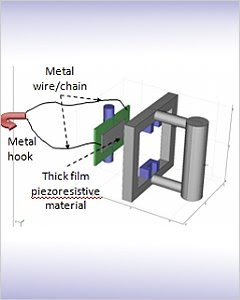
As news of Tiger Woods' knee injury hits the headlines, a researcher at the University of Southampton has developed a new self-powered sensor to monitor progress during knee operations.
As part of his final year project in his Masters degree in Electromechanical Engineering, which he studied at the University's School of Electronics and Computer Science (ECS), Fauzan Baharudin explored the potential for the use of thick film technology in the development of medical sensors which could be embedded in the knee during surgery.
This new sensor, called Serial In-vivo Transducer (SIT), which uses thick film technology, could measure tendon force during Anterior Cruciate Ligament (ACL) reconstruction.
The ACL is the most commonly injured ligament and is commonly damaged by athletes, in fact it is reported that this is the ligament associated with Tiger Woods' injury.
Fauzan's project was supervised by Professor Neil White at ECS, who, in 1991 developed thick film piezoelectric material which made it possible to produce a sensor which could power itself if it were installed in a device that vibrates and would be ideal for appliances where physical connections to the outside world were difficult.
Professor White said: 'Although this work is still in its infancy, our earlier research in thick-film sensors has shown that it is feasible to apply the technology to medical applications such as prosthetic hands. We have also shown that it is possible to harvest energy from the human body using piezoelectric materials and the knee is subjected to very high levels of force during everyday activities. It therefore seems logical to combine the two approaches to deliver a new type of embedded, self-powered sensors
In Fauzan's project entitled Assessing the use of thick-film technology in knee surgery: along with energy harvesting in-vivo, he has also incorporated some of this energy harvesting capability into SIT which means that it will be self-powered.
'I chose knee surgery because this has been very little research carried out in this field and I felt a self-powered device could work well in the knee,' he said.
Before developing SIT, Fauzan reviewed the existing devices in this field and concluded that due to its flexibility in fabrication, low capital cost, fast lead time and its suitability for use in the body, thick film technology is the best solution for ACL surgery. Assessment of the energy harvesting feature revealed that the device could produce more than enough energy to power itself.
'It remains a mystery to me, given how common knee injuries are among athletes, that devices like ours have not been developed before now,' said Fauzan. 'A sensible assumption for this is that thick film technology does not reach medical researchers as quickly as it does within the microelectronics community hence the delay in realising the huge potential in developing in vivo transducers.'
http://www.medicalnewstoday.com/articles/113764.php
http://www.ecs.soton.ac.uk/about/news/1914
http://www.sciencecentric.com/news/article.php?q=08070148
